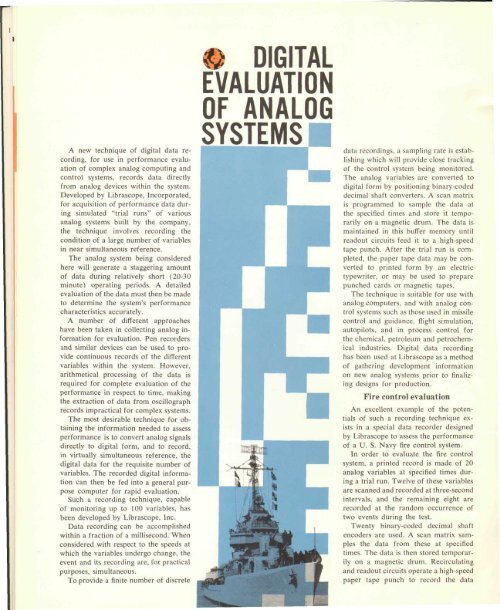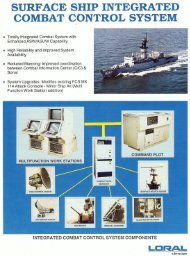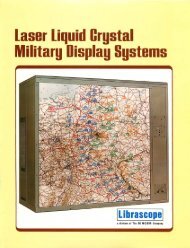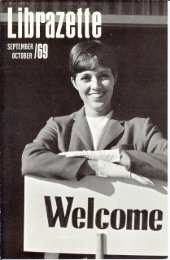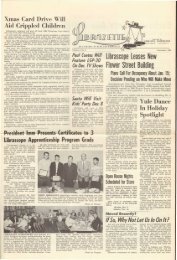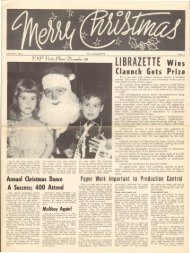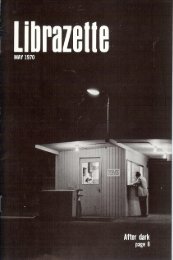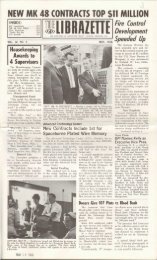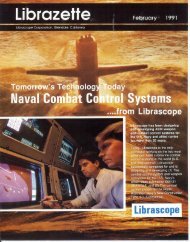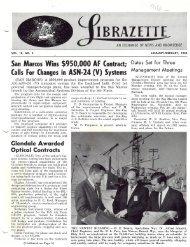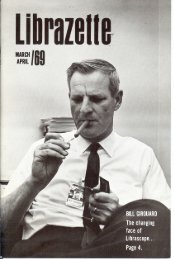Technical Review - Fall 1959. - Librascope Memories
Technical Review - Fall 1959. - Librascope Memories
Technical Review - Fall 1959. - Librascope Memories
Create successful ePaper yourself
Turn your PDF publications into a flip-book with our unique Google optimized e-Paper software.
A new technique of digital data recording,<br />
for use in performance evaluation<br />
of complex analog computing and<br />
control systems, records data directly<br />
from analog devices within the system.<br />
Developed by <strong>Librascope</strong>, Incorporated,<br />
for acquisition of performance data during<br />
simulated "trial runs" of various<br />
analog systems built by the company,<br />
the technique involves recording the<br />
condition of a large number of variables<br />
in near simultaneous reference.<br />
The analog system being considered<br />
here will generate a staggering amount<br />
of data during relatively short (20-30<br />
minute) operating periods. A detailed<br />
evaluation of the data must then be made<br />
to determine the system's performance<br />
characteristics accurately.<br />
A number of different approaches<br />
have been taken in collecting analog information<br />
for evaluation. Pen recorders<br />
and similar devices can be used to provide<br />
continuous records of the different<br />
variables within the system. However,<br />
arithmetical processing of the data is<br />
required for complete evaluation of the<br />
performance in respect to time, making<br />
the extraction of data from oscillograph<br />
records impractical for complex systems.<br />
The most desirable technique for obtaining<br />
the information needed to assess<br />
performance is to convert analog signals<br />
directly to digital form, and to record,<br />
in virtually simultaneous reference, the<br />
digital data for the requisite number of<br />
variables. The recorded digital information<br />
can then be fed into a general purpose<br />
computer for rapid evaluation.<br />
Such a recording technique, capable<br />
of monitoring up to 100 variables, has<br />
been developed by <strong>Librascope</strong>, Inc.<br />
Data recording can be accomplished<br />
within a fraction of a millisecond. When<br />
considered with respect to the speeds at<br />
which the variables undergo change, the<br />
event and its recording are, for practical<br />
purposes, simultaneous.<br />
To provide a finite number of discrete<br />
DIGITAL<br />
EVALUATION<br />
OF ANALOG<br />
SYSTEMS<br />
data recordings, a sampling rate is establishing<br />
which will provide close tracking<br />
of the control system being monitored.<br />
The analog variables are converted to<br />
digital form by positioning binary-coded<br />
decimal shaft converters. A scan matrix<br />
is programmed to sample the data at<br />
the specified times and store it temporarily<br />
on a magnetic drum. The data is<br />
maintained in this buffer memory until<br />
readout circuits feed it to a high-speed<br />
tape punch. After the trial run is completed,<br />
the paper tape data may be converted<br />
to printed form by an electric<br />
typewriter, or may be used to prepare<br />
punched cards or magnetic tapes.<br />
The technique is suitable for use with<br />
analog computers, and with analog control<br />
systems such as those used in missile<br />
control and guidance, flight simulation,<br />
autopilots, and in process control for<br />
the chemical, petroleum and petrochemical<br />
industries. Digital data recording<br />
has been used at <strong>Librascope</strong> as a method<br />
of gathering development information<br />
on new analog systems prior to finalizing<br />
designs for production.<br />
Fire control evaluation<br />
An excellent example of the potentials<br />
of such a recording technique exists<br />
in a special data recorder designed<br />
by <strong>Librascope</strong> to assess the performance<br />
of a U. S. Navy fire control system.<br />
In order to evaluate the fire control<br />
system, a printed record is made of 20<br />
analog variables at specified times during<br />
a trial run. Twelve of these variables<br />
are scanned and recorded at three-second<br />
intervals, and the remaining eight are<br />
recorded at the random occurrence of<br />
two events during the test.<br />
Twenty binary-coded decimal shaft<br />
encoders are used. A scan matrix samples<br />
the data from these at specified<br />
times. The data is then stored temporarily<br />
on a magnetic drum. Recirculating<br />
and readout circuits operate a high-speed<br />
paper tape punch to record the data


